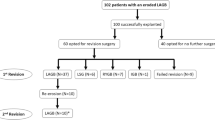Abstract
Background
The need for revision after laparoscopic adjustable gastric band (LAGB) surgery has been reduced over the past 10 years with the introduction of the pars flaccida technique, delicate band tightening, and concurrent hiatal hernia repairs. However, band revision still occurs for as many as 5% of patients. Placement of a lesser-curvature gastrogastric suture distal to the band is one newer technique suggested to lower band slippage. To evaluate the worth of this technique, the authors have investigated two groups of patients in their practice: one group with the plication stitch and one group without it.
Methods
This retrospective review examined data for 1,365 LAGB patients collected prospectively by an institutional review board-approved database between July 2007 and May 2010. One surgeon did not perform the plication stitch (n = 776) and one did (n = 589). The surgical techniques were very similar. The majority of the patients had crural repair at the primary operation. Band revision rates were assessed.
Results
For 1,365 patients, LAGB was performed safely. The mean follow-up period was 22 months. The two groups were similar. The no-stitch group consisted of 776 patients (496 women, 64%) with a mean age of 42 years, a mean weight of 278 lb, and a mean body mass index (BMI) of 44.6 kg/m2. The stitch group consisted of 589 patients (426 woman, 72%) with a mean age of 40 years, a mean weight of 278 lb, and a mean BMI of 44.8 kg/m2. The no-stitch group had an estimated weight loss (EWL) of 44% at 12 months and 50% EWL at 2 years. The stitch group had 37% EWL at 12 months and 45% EWL at 2 years. Both groups had very low revision rates. The no-stitch group had 4 revisions in 776 patients (0.26%), and the stitch group had 9 revisions in 589 patients (1.5%).
Conclusion
Adding gastrogastric plication sutures offers no benefit of reducing the rate of revision after LAGB surgery.
Similar content being viewed by others
References
Belachew M, Belva PH, Desaive C (2002) Long-term results of laparoscopic adjustable gastric banding for the treatment of morbid obesity. Obes Surg 12:564–568
Zinzindohoue F, Chevallier J, Douard R, Elian N, Ferraz J, Blance J, Berta J, Altman J, Safran D, Cugnnc P (2002) Laprascopic gastric banding: a minimally invasive surgical treatment for morbid obesity: a prospective study of 500 consecutive patients. Ann Surg 237:1–9
Spivak H, Hewitt MF, Onn A, Half EE (2005) Weight loss and improvement of obesity-related illness in 500 U.S. patients following laparoscopic adjustable gastric banding procedure. Am J Surg 189:27–32
Allen JW (2007) Laparoscopic gastric band complications. Med Clin North Am 91:485–497 xii
Ren CJ, Fielding GA (2003) Laparoscopic adjustable gastric banding: surgical technique. J Laparoendosc Adv Surg Tech A 13:257–263
O’Brien PE, Dixon JB (2003) Pars flaccida versus perigastric pathways for the placement of the lap-band system. Obes Surg 13:211
O’Brien PE, Dixon JB, Laurie C, Anderson M (2005) A prospective randomized trial of placement of the laparoscopic adjustable gastric band: comparison of the perigastric and pars flaccida pathways. Obes Surg 15:820–826
Fielding GA, Duncombe JE (2005) Clinical and radiological follow-up of laparoscopic adjustable gastric bands: a comparison of two techniques. Obes Surg 15:634–640
Ponce J, Paynter S, Fromm R (2005) Laparoscopic adjustable gastric banding: 1,014 consecutive cases. J Am Coll Surg 201:529–535
Egan RJ, Monkhouse SJ, Meredith HE, Bates SE, Morgan JD, Norton SA (2011) The reporting of gastric band slip and related complications: a review of the literature. Obes Surg 21:1280–1288
Parikh MS, Fielding GA, Ren CJ (2005) U.S. experience with 749 laparoscopic adjustable gastric bands: intermediate outcomes. Surg Endosc 19:1631–1635
Gulkarov I, Wetterau M, Ren C, Fielding G (2008) Hiatal hernia repair at the initial laparoscopic adjustable gastric band reduces the need for reoperation. Surg Endosc 22:1035–1041
Brethauer SA, Harris JL, Kroh M, Schauer PR (2011) Laparoscopic gastric plication for treatment of severe obesity. Surg Obes Relat Dis 7:15–22
Disclosures
Marina S. Kurian has received an honorarium and a grant from Allergan Medical. Christine Ren Fielding has received an honorarium and a grant from Allergan Medical. She has served as a consultant for the Surgical Review Committee and ExploraMed. George A. Fielding has received an honorarium and a grant from Allergan Medical and an honoraium from Ethicon Endosurgery. Jonathan Zagzag, Bradley F. Schwack, Heekoung Youn have no conflicts of interest or financial ties to disclose.
Author information
Authors and Affiliations
Corresponding author
Rights and permissions
About this article
Cite this article
Zagzag, J., Schwack, B.F., Youn, H. et al. Does adding a lesser-curvature gastrogastric plication suture reduce the need for revision after laparoscopic adjustable gastric band placement?. Surg Endosc 26, 514–517 (2012). https://doi.org/10.1007/s00464-011-1910-z
Received:
Accepted:
Published:
Issue Date:
DOI: https://doi.org/10.1007/s00464-011-1910-z




